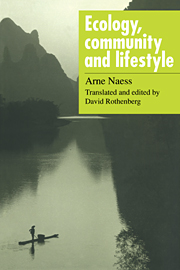Book contents
- Frontmatter
- Contents
- Translator's preface
- Introduction: Ecosophy T – from intuition to system
- 1 The environmental crisis and the deep ecological movement
- 2 From ecology to ecosophy
- 3 Fact and value; basic norms
- 4 Ecosophy, technology, and lifestyle
- 5 Economics within ecosophy
- 6 Ecopolitics within ecosophy
- 7 Ecosophy T: unity and diversity of life
- Bibliography
- Index
1 - The environmental crisis and the deep ecological movement
Published online by Cambridge University Press: 13 October 2009
- Frontmatter
- Contents
- Translator's preface
- Introduction: Ecosophy T – from intuition to system
- 1 The environmental crisis and the deep ecological movement
- 2 From ecology to ecosophy
- 3 Fact and value; basic norms
- 4 Ecosophy, technology, and lifestyle
- 5 Economics within ecosophy
- 6 Ecopolitics within ecosophy
- 7 Ecosophy T: unity and diversity of life
- Bibliography
- Index
Summary
The gravity of the situation
Humankind is the first species on earth with the intellectual capacity to limit its numbers consciously and live in an enduring, dynamic equilibrium with other forms of life. Human beings can perceive and care for the diversity of their surroundings. Our biological heritage allows us to delight in this intricate, living diversity. This ability to delight can be further perfected, facilitating a creative interaction with the immediate surroundings.
A global culture of a primarily techno-industrial nature is now encroaching upon all the world's milieux, desecrating living conditions for future generations. We – the responsible participants in this culture – have slowly but surely begun to question whether we truly accept this unique, sinister role we have previously chosen. Our reply is almost unanimously negative.
For the first time in the history of humanity, we stand face to face with a choice imposed upon us because our lackadaisical attitude to the production of things and people has caught up with us. Will we apply a touch of self-discipline and reasonable planning to contribute to the maintenance and development of the richness of life on Earth, or will we fritter away our chances, and leave development to blind forces?
A synopsis of what it is which makes the situation so critical could read:
An exponentially increasing, and partially or totally irreversible environmental deterioration or devastation perpetuated through firmly established ways of production and consumption and a lack of adequate policies regarding human population increase.
- Type
- Chapter
- Information
- Ecology, Community and LifestyleOutline of an Ecosophy, pp. 23 - 34Publisher: Cambridge University PressPrint publication year: 1989



